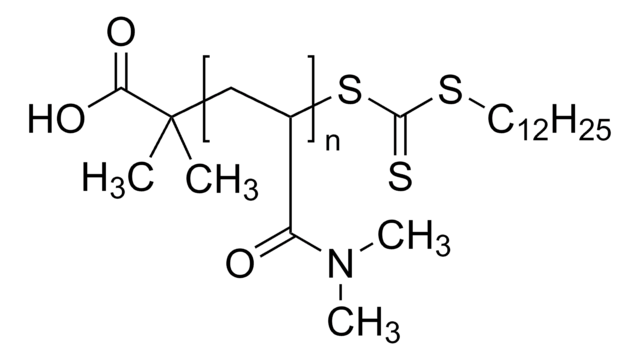About This Item
おすすめの製品
形状
powder
分子量
average Mv 20,000
転移温度
Tg 84.8 °C
密度
1.15 g/mL at 25 °C (lit.)
SMILES記法
CC(=C)C(=O)OCCO
InChI
1S/C6H10O3/c1-5(2)6(8)9-4-3-7/h7H,1,3-4H2,2H3
InChI Key
WOBHKFSMXKNTIM-UHFFFAOYSA-N
類似した製品をお探しですか? 訪問 製品比較ガイド
関連するカテゴリー
アプリケーション
- Hydrogen-bonds structure in poly(2-hydroxyethyl methacrylate) studied by temperature-dependent infrared spectroscopy:温度依存赤外分光法を使用して、ポリ(2-ヒドロキシエチルメタクリラート)(PHEMA)の水素結合構造を調べています。(S Morita, 2014)。
- Transparent and tough poly(2-hydroxyethyl methacrylate) hydrogels prepared in water/IL mixtures:さまざまな生物医学用途で使用できる可能性のある、頑強で透明なPHEMAハイドロゲルの開発について記述しています。(Y Liu et al., 2020)。
- Reduced cell attachment to poly(2-hydroxyethyl methacrylate)-coated ventricular catheters in vitro:カテーテルなどの生物医学デバイスにおける利点として、PHEMAコーティングが細胞付着性をどのように低減できるかを調べています。(BW Hanak et al., 2018)。
- Surface modification of poly(2-hydroxyethyl methacrylate) hydrogel for contact lens application:コンタクトレンズ用途への適合性を改善するためのPHEMAハイドロゲルの修飾について研究しています。(M Kazemi Ashtiani, M Zandi, 2018)。
物理的形状
保管分類コード
11 - Combustible Solids
WGK
WGK 3
引火点(°F)
Not applicable
引火点(℃)
Not applicable
個人用保護具 (PPE)
Eyeshields, Gloves, type N95 (US)
適用法令
試験研究用途を考慮した関連法令を主に挙げております。化学物質以外については、一部の情報のみ提供しています。 製品を安全かつ合法的に使用することは、使用者の義務です。最新情報により修正される場合があります。WEBの反映には時間を要することがあるため、適宜SDSをご参照ください。
Jan Code
529265-BULK:
529265-VAR:
529265-5G:
529265-25G:
試験成績書(COA)
製品のロット番号・バッチ番号を入力して、試験成績書(COA) を検索できます。ロット番号・バッチ番号は、製品ラベルに「Lot」または「Batch」に続いて記載されています。
この製品を見ている人はこちらもチェック
資料
Professor Shrike Zhang (Harvard Medical School, USA) discusses advances in 3D-bioprinted tissue models for in vitro drug testing, reviews bioink selections, and provides application examples of 3D bioprinting in tissue model biofabrication.
Shrike Zhang教授(Harvard Medical School、米国)が、in vitroの薬物試験のための3Dバイオプリンティング組織モデルの進展について述べ、バイオインクの選択基準と組織モデルのバイオファブリケーションにおける3Dバイオプリンティングの応用例を紹介します。
アルキルチオラート、アルキルシラン、アルキルホスホン酸の自己組織化単分子層(SAMr)を利用したフォトパターニングについて紹介します。
Self-assembled monolayers (SAMs) have diverse applications; article compares benefits of alkylthiolates on gold SAM systems.
プロトコル
Frequently asked questions (FAQs) for KAPA SYBR® FAST One-Step qRT-PCR Kits.
ライフサイエンス、有機合成、材料科学、クロマトグラフィー、分析など、あらゆる分野の研究に経験のあるメンバーがおります。.
製品に関するお問い合わせはこちら(テクニカルサービス)










